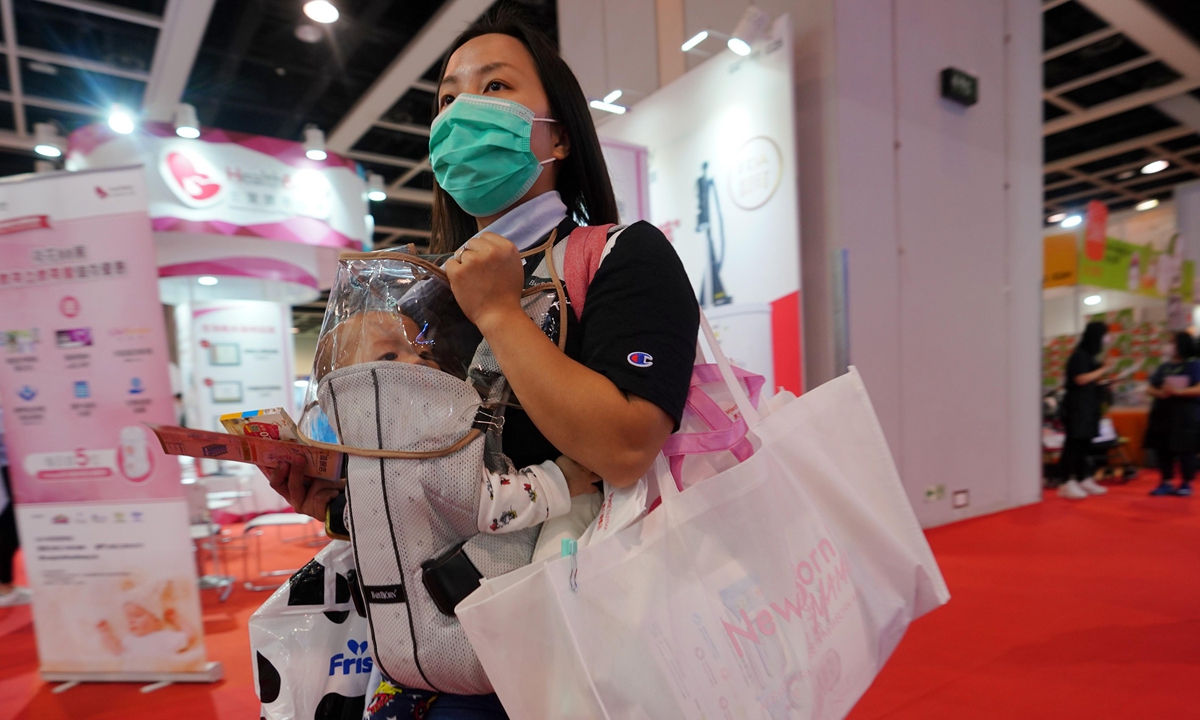Shenzhen sees influx of HK residents fleeing epidemic
By Lu Wenao in Shenzhen and Liu Caiyu in Beijing Source: Global Times Published: 2020/12/7 17:08:41 Last Updated: 2020/12/8 0:30:02
Experts warn of 5th wave of outbreaks as Christmas approaches

A mother takes full preventative measures against the coronavirus with her child when attending the 28th International Baby/Children Products Expo at the Hong Kong Convention and Exhibition Centre on Thursday, which is the first expo in Hong Kong after the Hong Kong government announced to reopen exhibitions on September 18. Photo: VCG
There has been a spike in the number of people from Hong Kong Special Administrative Region (HKSAR) entering the Chinese mainland via Shenzhen Bay Port in South China's Guangdong Province, with numbers of up to 3,000 in one day, as the fourth wave of the epidemic engulfs the international financial hub.
Long lines of people were seen waiting to make their way through the Shenzhen Bay Checkpoint and be picked up to receive 14 days of quarantine, the Global Times found on Monday.
Queuing travelers were provided with chairs and canopy shelters outside the entry hall, as they had to wait for buses to send them to quarantine hotels. Some said they had to wait several hours before completing the quarantine procedures at customs and be sent to hotels.
A Hong Kong resident surnamed Tan told the Global Times that she arrived at Shenzhen Bay Port around 2 pm on Sunday and passed customs at 5 pm, and eventually checked in to a hotel at around 11 pm.
"Lines of people were waiting. The whole procedure is just too slow," she said. It is the only opening port between Hong Kong and Shenzhen, as other ports in Shenzhen are temporarily closed due to COVID-19 prevention policies. Hong Kong recorded a spike in confirmed cases with 101 new cases found on Saturday and 95 on Sunday.
The number of Hong Kong residents entering Shenzhen Bay port reached 2,700 on December 1 and reached its peak of 3,060 on December 2, according to data compiled by the Hong Kong Immigration Department. On Sunday, the number stayed at 1,761, the Global Times found. The normal daily influx of Hong Kong residents into Shenzhen Bay port is usually in the hundreds.
In early July when the second wave of the epidemic broke out in Hong Kong, the number of Hong Kong residents entering Shenzhen through Shenzhen Bay Port also saw a rapid increase.
Local hotels have been fully registered every day for the last seven days, a staff member at a Vienna Hotel branch, which has been designated as a quarantine hotel, told the Global Times.
"As the port has seen increasing passenger numbers coming in, we've been receiving increasing numbers of guests," the staff said.
It will take a long time before government officials sort out how to arrange them into hotels for quarantine, as the designated hotels are basically at full capacity, the staff member said.
The majority of the cross-border travelers are students, as schools in Hong Kong have ended their semester early due to the epidemic, a medical worker in a protective suit working at the Shenzhen Bay Port told the Global Times on Monday. Tan also said many students together with their parents have been seen crossing the border at the port.
Hong Kong is currently experiencing the fourth wave of COVID-19 epidemic, which mostly involves high-income groups and elites. Many local transmission cases are of unknown sources, as elites are reluctant to cooperate in divulging their travel histories, Jin Dongyan, a professor at the School of Biomedical Sciences at the University of Hong Kong, told the Global Times on Monday.
The fourth wave, which saw a peak around November 23, is in a slow downward trend, Jin said, adding that the R0 number in the city currently remains at around 1, meaning the epidemic in the city is controllable. But achieving zero infections will be difficult, as the city has been running normally since the epidemic and borders remain open for international travelers.
As Christmas approaches, Jin warned of increasing risks, saying Hong Kong may see its fifth wave of outbreaks if people cannot properly follow anti-epidemic social distancing guidelines.
Recent COVID-19 infections from Hong Kong has prompted the border city of Shenzhen to tighten measures, as the mainland city has been focused on preventing the epidemic from flaring up. Observers said Shenzhen will feel pressure but believed it could get through it, given its vast experience in handling imported cases.
Shenzhen reported one imported asymptomatic case on Saturday who was a resident of Hong Kong. The man had come to Shenzhen via Shenzhen Bay Checkpoint and was quarantined upon arrival, Shenzhen health authorities said.
In early December, a truck driver who commutes between Hong Kong and Shenzhen and one of his close contacts were confirmed to have the coronavirus, which prompted communities in Shenzhen to roll out tests on all related residents who might have had contact with him.
In a bid to better manage drivers who commute between the two cities, the Global Times learned that the mainland city has required drivers to register online before crossing the border and scan their health codes when they reach their destination. Besides, they must have obtained a negative nucleic acid test within the last seven days.
Drivers had previously tested every three days, but now the test will be conducted daily. Due to the increasing testing frequency, long queues were also seen among drivers waiting to get tested while crossing the ports, staff from the Hong Kong Federation of Trade Unions said.
Posted in: SOCIETY,HK/MACAO/TAIWAN